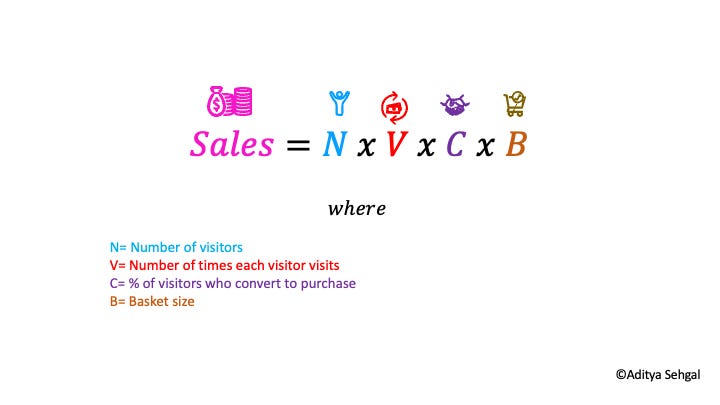The Framework:
This framework applies to every business.
Your customers drive sales by coming to your store (online or offline), visiting more often, converting more of them to buy and them buying a more significant amount each time.
This framework is powerful for two reasons:
The multiplicative effect of the variables leads to hyper-growth
Continuous optimisation of each variable over time leads to concrete tools to manage and grow the business.
Hyper Growth:
Say a 100 people visit your store ten times a year. 5% buy an average of $100 each time. In that case, you sell $5000 in the year.
How can you grow your business by 50%?
Just improve each variable by 10%! i.e. if 110 people visit your store 11 times each year and 5.5% of them buy $110 each time, your sales will grow by almost 50%
How can you grow your business 5X?
Optimise each variable by 50%
How can you grow your business 16X?
Convince 2X the people (200) to visit your store 20 times each year, improve your execution and products and reduce friction so that 10% of them buy $200 each time!
You get the picture!
Implementing the framework:
By building additively on the four variables, we create a multiplicative effect on growth!
You can create a compounding effect to grow each variable over time, and the multiplicative effect on compounding these four variables can drive exponential hyper-growth.
Improving each variable by 2.5% every month for 36 months leads to each variable increasing to 2.4X, but the business's total revenue will grow 30X!
To implement the framework, we deconstruct the drivers of each variable and then set up teams and workflows focused on the continuous improvement of each driver.
Metrics and measurement systems track progress over time (days, weeks, months and years), incentivising our teams to improve each variable continuously:
The number of people visiting: Otherwise called traffic. You influence it by deciding the location of your store, investing in advertising, the attractiveness of your store (visual merchandising), the popularity of your product category and the clarity of your proposition.
The number of times each visitor visits: Otherwise called repeat. Improve it by providing a Wow! experience, provide a service on top of just the physical product, leverage your CRM and outreach programs, loyalty and ambassador programs, create repeat purchase discounts…
% of visitors who convert to purchase: Otherwise called conversion rate. Work to drive it by reducing the friction on your website/store through continuous optimisation, create events (like 11-11 or black Friday), offer trial sizes, financing programs, 'only available now' offers, pricing to meet psychological price points. Give people pre-information via advertising and CRM before they come to your store, create a program to manage leads and take them through the sales funnel. Cross-sell products at checkout. Follow up diligently on dropped carts and unfilled orders. Reach out to visitors who did not buy after some time with offers and understand what you could do to help them buy. drive optimisation using tools like A/B testing, user journey optimisation, behaviour tracking and more
Basket size: Improve basket size with larger size offerings, cross-sell, upsell at the point of purchase. Merchandise bigger packs at eye level, use banner spaces on websites to show bundles. At checkout, relentlessly upsell - give offers on increasing items in the basket. Include helpful suggestions like 'bought together often'. You would personalise your offer and product as much as possible.
Choose from an infinite variety of creative strategies to drive each of these metrics.
Remember that each of these metrics will compound on an S curve (more of that in a future framework). Consider the life-cycle stage for each metric to get to the next level of growth.
By bringing transparency to these prime metrics of the business, you force the team to focus on the growth drivers, which are core instead of on peripheral fluff.
Through relentless optimisation, you accelerate them on the experience curve (more on this later), and the value of this experience eventually becomes the 'secret execution sauce' that makes your business different and successful.
Applications:
This framework works with EVERY business. It is equally applicable to a sales rep doing a route to a pure-play online business.
Structuring teams: Use this framework to structure teams to focus on the four variables' key drivers. For example, if you are an online business, structure your people into a traffic team, consumer experience team, product team and customer relationship team. A combination of metrics of these teams will give you complete granular control of every aspect of your business.
Reporting: Make sure you can see these variables and their drivers in your reporting. Connect the reporting to sales numbers. Each person in your team will see the cumulative impact of their efforts on the business and where they 'fit' in the larger scheme of things.
Further reading:
https://adityasehgal.com/2014/07/13/business-and-bacteria-how-things-grow/
https://hbr.org/2008/04/managing-hypergrowth









Thank you for this clear, practical framework, Adi. On the variable of basket-size, I think it’s useful to specifically call out “trade-up”; i.e. converting the particular purchase occasion to the higher value per use / better performing / better profitability solution of the same brand => something we learnt from Gillette blades, and relentlessly implemented on Finish tabs/caps, Durex condoms, Vanish stain removers, etc.
Another call out for me is that, over the long run, out of all the variables here, the “traffic / penetration” is ”the first among equals”: Unless one has a strong penetration base, there is not much leverage to be had through pulling other levers, as +300% growth over a “limited” base is still “limited”.
Anyway, my quick reaction to the very useful framework you architected here. Cheers, again.
Very interesting Adi, thanks. How would this apply to the service (instead of product) business? And/or to the B2B (instead of the B2C) model?